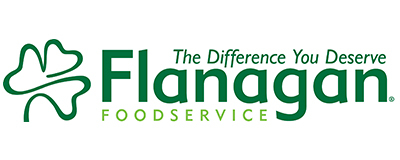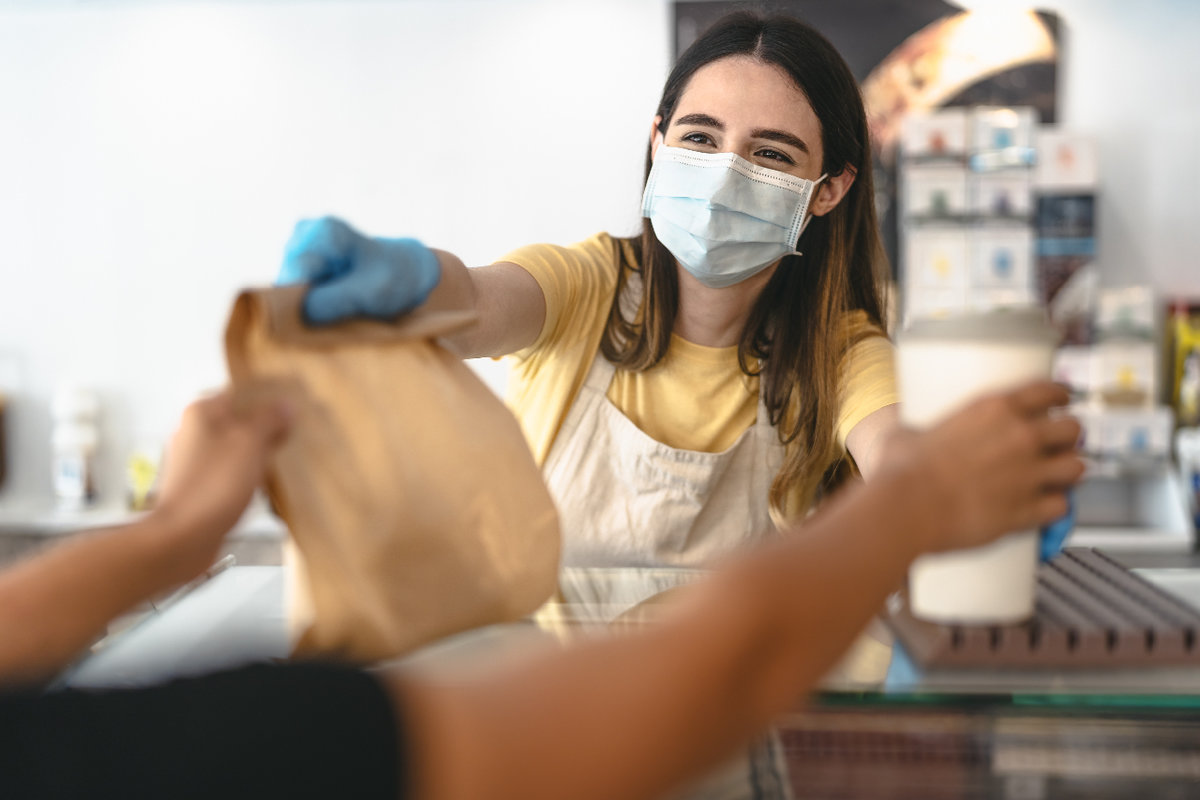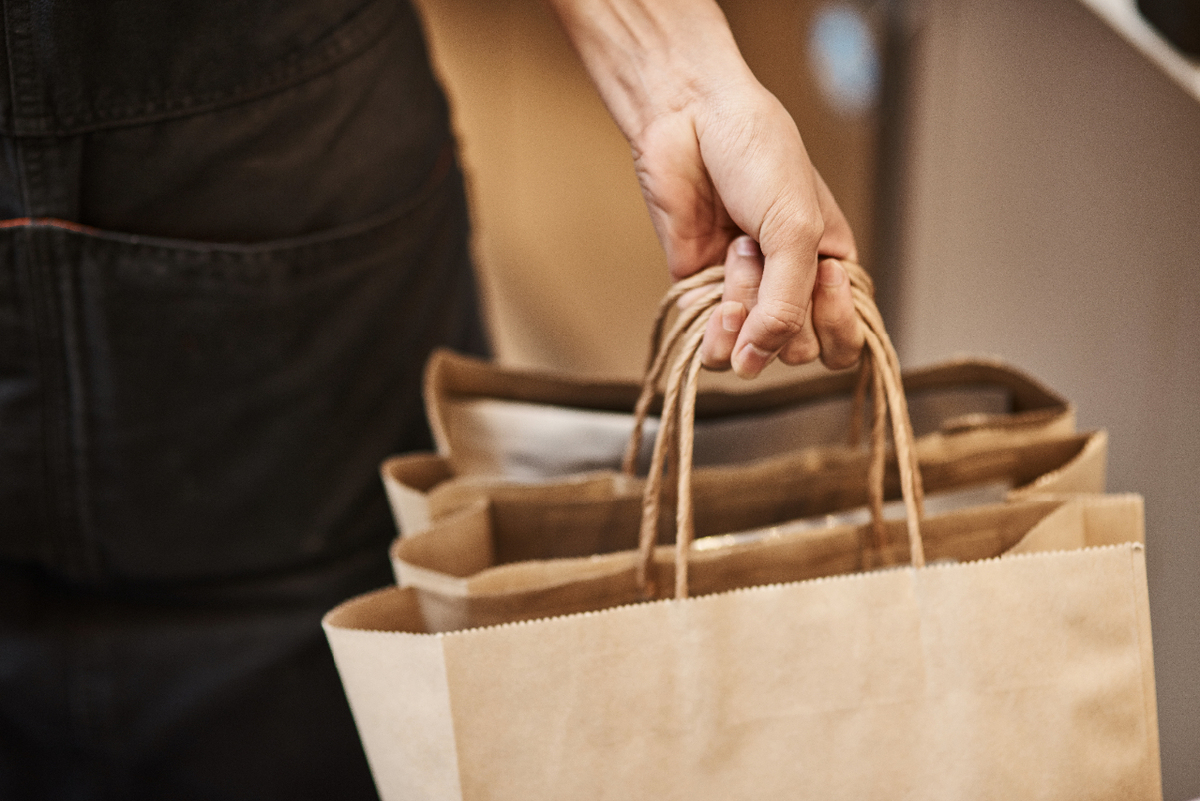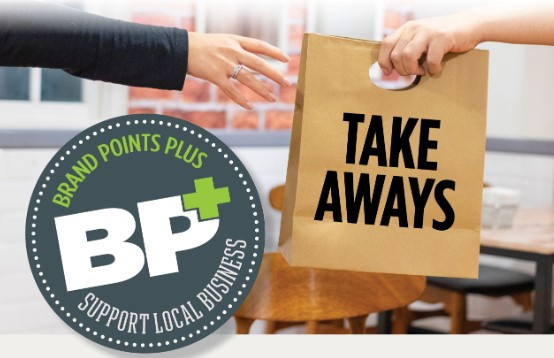
We collect basic website visitor information on this website and store it in cookies. We also utilize Google Analytics to track page view information to assist us in improving our website.

How are servers – and other restaurant staff – connecting with guests now that they have to wear face masks and avoid contact? And how do guests know when servers are smiling?
The personal touch is a key part of the restaurant experience, but new safety protocols have upended that experience. Servers need to work extra hard to create that feeling of welcome. Has the thumbs-up become a new form of communication between servers and guests to signify satisfaction? Or has “eye talk” become the norm? And how are operators training staff to replicate the warm, welcoming feeling of the “old days”?
“Smiling is part of service,” says Jeff Dover, Principal at fsStrategy Inc. “So, with masks, eye contact is important.” Masks can be adapted, he adds:
Changes to server communication need to be part of a bigger strategy of letting guests know what you are doing to keep them safe.
Here are other tips from Dover for servers adjusting to the new restaurant normal. Many of them, you have probably already instituted:
“…it is about making people feeling comfortable dining again,” Dover says. “I also think thanking them for coming back and supporting your business will go a long way and be appreciated.
Jane Auster is the editor of ChefConnexion.com. She has been a foodservice writer and editor for more than 30 years. Jane was the editor of Your Foodservice Manager, a national magazine for professionals in the foodservice and hospitality industry in Canada, and FoodBiz.ca digital site. She was also an editorial consultant and managing editor for the relaunch of Flavours magazine.
Visit chefconnexion.com for more articles

Until March 2020, 4,800-sq. ft. fine dining restaurant Rae's Bistro, in North Kildonan, Winnipeg, was a popular spot offering fusion comfort food. Co-owned by Jillian Flynn and Danny Van Lancker, Rae's was noted for its 50-bottle wine list, 12 craft beers, scotch flights, and a premium atmosphere appealing to an adult clientele.
"We were known for our service and fresh feature chalkboard (rotated weekly), and guests would come in to hear our staff 'romance' the 10 features to them. It was almost a form of entertainment," says Danny.
Before March 17, Rae's Bistro did not offer any takeout or delivery
"We were just too busy to seek other revenue streams. We were on track to do $1.5 million in sales our second fiscal year. We were busy all the time (from 11 a.m. to midnight or later, if demand was there), with lineups, reservations, loud bar top, funky new age music, cool looking staff."
All that changed on Friday, the 13th - auspicious!
By Monday, March 16, sales had declined 60%. On the next day, Rae's Bistro closed to the public for dine in.
"On Monday, we reached out to the local health authority for advice and spent the day researching the science behind the pandemic and looking at the leading scientists' predictions/models. Pratt's (a great partner to have) obtained proper viral sanitation products for us.
"We jumped into action immediately. We laid off 22 staff by issuing emergency payroll and ROEs, and all staff applied for EI by Friday. Our first reaction was concern for the Rae’s family. It was completely devastating to think about taking away 22 people's source of income."
Rae's kept on a core staff – culinary, suppliers, the CFO – to adapt to the new reality. Within a matter of two days, working around the clock, the team approached their task with military precision. They created a takeout menu, bought Safeway thermal boxes to launch the service, designed banners for the windows, printed temporary menus, completely revamped the website to focus on the takeout menu, and branded takeout bags with personalized messages and menus.
All packaging is recycled brown paper, and even the takeout cutlery is wood, as the co-owners are committed to respecting the environment. (In fact, that is one of the reasons they had not considered offering takeout before.)
"By Friday, March 20th, we realized this might work, with two takeout specialists on staff, two drivers, and an additional kitchen employee we brought back. Much to our surprise, by Saturday, it was working and offering a flawless experience to all guests. Our delivery team is now our two veteran servers and bartender. We take responsibility for each order, text when on the way, and follow up with guests...treating them as a table and not a delivery. I personally close every box and write a thank you note to this day. I insist on a proper food chain of command. Safety officer/expo is my new position."
You need to accept that your regular menu likely will need adaptation. The Rae's team streamlined their menu to focus on high quality sandwiches, snacks, pizzas, pastas, steaks, ribs and fish.
"Stuff that travels well, and a lower price point for our entrées (not a discount, just not over-$30 items). People are going to be eating comfort, and more often now. We need to focus on our lower priced items without sacrificing our commitment to quality."
Labour modelling, having to do it day by day as there is no past to use for forecasting.
Infrastructure, going from a single (phone) line to multiple lines with busy signal.
Communicating continued relevance to the public.
Delivery tracking, estimating and planning.
Installing mobile POS terminals for at-door payments.
Figuring out how to translate personalized service to guests in a different way.
By pivoting quickly and effectively, Rae's was able to turn around the operation from dine-in to takeout/delivery – and see significant sales increases.
From a modest beginning on March 18 to see if takeout and delivery would even work, Rae's is now up to nearly $7,000 in sales on the weekend and $1,000-$1,700 on weekdays. A scheduled postal drop of advertising may see even higher numbers.
Focus on the personal touches
This post was shared in connection with Brand Points Plus, a FREE loyalty program for independent operators. Easily collect points for amazing rewards, if you're not a member - we highly recommend you become one.
Learn more about Brand Points Plus

by Jane Auster
This post was written by Jane and the Brand Points Plus team. If you're not a member, this is an amazing, no-cost loyalty program. To learn more click here.
Flexible restaurant operators are converting from eat-in to takeout during the COVID-19 pandemic. And whether they're fine dining, QSR or casual eating establishments, they're finding it's not as hard as you may think to revamp an eat-in operation. Also, according to infectious disease specialist Isaac Bogoch, the risk of contracting the virus from takeout and delivery is "so extraordinarily small" – good news for consumers and restaurant operators alike.
Make ordering and payment a snap. Many diners, especially Millennials, are already conversant with online and app ordering. Make sure your web and app menu allows for easy ordering and that you're capable of receiving text message orders and app orders from mobile devices. Then add a pre-payment option to make the whole process seamless. Companies like cloud-based commerce platform Lightspeed POS Inc. have set up special resources during the crisis to help restaurants who are converting operations to takeout and delivery.
Change up your restaurant layout. Without the need to provide tables and chairs for traditional eat-in dining, you can easily convert that space into takeout/delivery work stations. Think assembly line in the way you organize your takeout operation.
Revisit your staffing. There's no doubt you will not need the same number of employees as a full-service restaurant requires. But you will want to retain as many as possible to keep you up and running professionally and prepare for a return to more normal operations. Now is the time to redeploy your talent. You'll still need cooks (short order especially), cleaners, order takers and payment processors, delivery staff, and quality control personnel. You may also need a person assigned specifically to answer customer questions about your menu, takeout and delivery options, payment, and so on.
Carefully consider your menu. Not everything on your regular menu will be suitable for takeout and delivery. A takeout menu is more a snapshot of your full offerings. Confine your takeout to top sellers (as long they're not too elaborate or time-consuming to prepare), dishes that will transport well in takeout and delivery, and entries that will still give you a good return on investment.
Use the right packaging for the job. No one likes to pick up or receive soggy, leaking, messy or unattractive food packages. Companies like W. Ralston, Novolex and Polar Pak feature packaging specifically for foodservice operations that include takeout and delivery, and also packaging that's size-appropriate. “The packaging a French fry requires for travel is different than a pasta dish. And packaging will also depend on the miles or time it needs to travel,” says John Veder, director of innovation - paper for Novolex North America. Also consider packaging that can be easily reheated without having to be transferred to other dishes.
“With takeout, the customer is in control of when that food is consumed,” says Veder. “For delivery, the customer is at home, waiting. Their expectation is that the food is ready to eat. Not soggy. Not cold.”
Make delivery easy. "Delivery was a growing market segment prior to COVID-19," says foodservice principal Jeff Dover of fsStrategy Inc. "Restaurants have been adjusting delivery menus to include products that hold well and working on takeout containers that hold the food well. Increasingly, they are looking for tamper proof containers. If a restaurant hasn't worked through this yet, they may want to think about it before going full delivery. If they don't normally do takeout or delivery, they will need to get the packaging."
If you're new to delivery, you may want to partner with an established foodservice delivery company like Uber Eats, DoorDash, Foodora, or Skip the Dishes. Uber Eats has announced that the company is waiving its normal delivery fees for customers who order from independent restaurants and allowing restaurants to receive payment daily instead of on a regular billing cycle in order to help their cash flow. Door Dash has said it will be not be collecting service fees for the first 30 days for a new restaurant client. Restaurants who partner with delivery services also benefit from the online exposure on food delivery sites.
Do it yourself? Some restaurants are choosing to do their own delivery by training their regular waitstaff to become delivery door-dashers. In the short term this is a great way to continue employing front-of-house staff. But don't forget to check your insurance to make sure your staff are covered for "other" employment within your operation.
What kind of vehicle will you need? Motorized, bike delivery, or via public transit?
What's your radius? How far are you willing to travel for your customers? During this difficult period, literally going the extra mile will make a huge difference and help retain loyalty.
How's your branding? What kind of branding will you use to stand out? The big food delivery companies are able to advertise themselves through their distinctive, logo-ed carry-on packaging. Like the big guys, your new visual identity as takeout and delivery food providers matters. Consider branding your takeout packaging with your company logo and tagline or marketing messages. Market and promote the service on your website as well.
Ramp up your social media. Never has your social media been more important. It's your direct conduit to customers, a way to let them know that you are still in business and you value their patronage and support. If you're adding takeout and delivery, you need to spread the word. Social media such as Instagram, Facebook and other community pages can let people know you are open and active. Don't be afraid of doing something different and a little crazy on your Instagram. Get personal, do a virtual meal in your restaurant and film it, sing an aria outside your restaurant and post to your Instagram.
You may also want to create an old-fashioned paper flyer with your takeout menu and have a staff member deliver it to your local area. Sometimes old school is the best school. The point is to communicate as often as you can with customers to keep them close. And don't forget to thank them. They want to help.
Get creative. Some clever restaurants are throwing in extras with customers' takeout and delivery orders. Have any logo-ed t-shirts on hand? Send one with each order. Do you make any branded food items for sale, such as jams? Add one to each order. A restaurant in Toronto is even offering to throw in a roll of toilet paper to food orders made through Uber Eats.
Yes, you can deliver food during the Coronavirus pandemic. Here's how!
In an effort to prevent further spread of COVID-19 people will be social-distancing, and the demand for at home delivery orders will be drastically increasing. How can your business make sure that they are prepared to deliver food to customers safely?
According to the CDC and FDA, COVID-19 cannot be transmitted through food. The possibly more significant issue is spreading the virus from food delivery driver to customer or vice-versa. However, your restaurant can deliver food during the pandemic as long as you take the proper precautions, here's how:
Any food delivery drivers who have been diagnosed with COVID‑19 should be individually asked to self‑isolate by management to avoid any further spread of the virus. As a business, it is in your best interest to remain transparent to customers on your policies regarding sick employees.
It is essential to keep up to date with restaurant best practices for food handling at this time. This includes ensuring proper sanitation of surfaces, food handlers and food preparation environments, and that all food is properly sealed in tamper‑evident packaging.
A few extra cents to buy the right to-go packaging will end up saving you in the long run by preventing damaged food and keep items fresh for longer. To stand out amongst competition, you can try trendy ECO-friendly packaging as well. Also, clear packaging allows food delivery drivers to check orders at-a-glance before leaving the restaurant and completing the delivery. This will avoid and confusion or mistakes.
For the safety of your delivery drivers and customers it may be best for them to avoid 1-1 contact with each other. While the customer is ordering food, make a note to ask what their preferred delivery instructions are, and ask if it is possible to leave the food in an alternative location, for example placing food at the door.
Hand washing is the most important thing people can do to protect themselves and others. Provide food delivery drivers with disinfectant wipes, hand sanitizer, as well as gloves to help them protect themselves and keep their vehicles clean of any germs. Germs can live on surface, instruments and packaging that people touch, including take-out containers and utensils for nine days. Other recommended hygiene practices include not touching your face with unwashed hands, as well as making sure to cough or sneeze into a bent elbow or tissue.
The health and safety of your food delivery drivers and customers is the top priority in times such as these. Make sure to take proper precautions to keep everyone safe.
If you would like further advice on your safe food delivering options please contact your territory manager.

